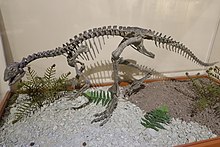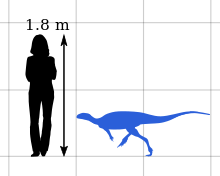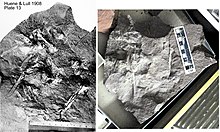Nanosaurus
| Nanosaurus Temporal range:Late Jurassic,
| |
|---|---|

| |
| Reconstructed skeleton cast,Dinosaur Journey Museum | |
| Scientific classification | |
| Domain: | Eukaryota |
| Kingdom: | Animalia |
| Phylum: | Chordata |
| Clade: | Dinosauria |
| Clade: | †Ornithischia |
| Clade: | †Genasauria |
| Clade: | †Neornithischia |
| Family: | †Nanosauridae Marsh,1877 |
| Genus: | †Nanosaurus Marsh,1877 |
| Species: | †N. agilis
|
| Binomial name | |
| †Nanosaurus agilis Marsh, 1877
| |
| Synonyms | |
|
Genus synonymy
Species synonymy
| |
Nanosaurus( "small or dwarf lizard" ) is the name given to agenusofneornithischiandinosaurthat lived about 155 to 148 million years ago, during theLate Jurassic-age. Itsfossilsare known from theMorrison Formationof the south-westernUnited States.Thetypeand onlyspecies,Nanosaurus agilis,wasdescribedand named byOthniel Charles Marshin 1877. Thetaxonhas a complicated taxonomic history, largely the work of Marsh andPeter M. Galton,involving the generaLaosaurus,Hallopus,Drinker,Othnielia,andOthnielosaurus,the latter three now being considered to be synonyms ofNanosaurus.It had historically been classified as ahypsilophodontorfabrosaur,types of generalized small bipedal herbivore, but more recent research has abandoned these groupings asparaphyleticandNanosaurusis today considered abasalmember of Neornithischia.
Description
[edit]
Nanosaurusis known from material from all parts of the body, including two good skeletons, although the skull is still poorly known.[1]It was a small animal, with specimens previously assigned toDrinkerandOthnielosaurusmeasuring 2–2.2 metres (6.6–7.2 ft) long and weighing 20–30 kilograms (44–66 lb).[2]
It was a bipedal dinosaur with short forelimbs and long hindlimbs with largeprocessesformuscleattachments.[3]The hands were short and broad with short fingers. The head was small. It had small leaf-shaped cheek teeth (triangular and with small ridges and denticles lining the front and back edges), andpremaxillaryteeth with less ornamentation.[4]
Like several other neornithischian dinosaurs, such asHypsilophodon,Thescelosaurus,andTalenkauen,Nanosaurushad thin plates lying along the ribs. Called intercostal plates, these structures werecartilaginousin origin.[5]
History and taxonomy
[edit]Marsh's original groundwork
[edit]

Nanosaurushas had a long and complicated taxonomic history. In 1877, Marsh named two species ofNanosaurusin separate publications, based on partial remains from the Morrison Formation ofGarden Park,Colorado.One paper describedN. agilis,based onYPM1913, with remains including impressions of adentary,andpostcranialbits including anilium,thigh bones,shin bones,and afibula.[6]The other paper namedN. rex,a second species which Marsh based on YPM 1915 (also called 1925 in Galton, 2007), a complete thigh bone.[4][7]He regarded both species as small ( "fox-sized" ) animals.[7]A third species,N. victor,was named, which he soon recognized to be something completely different, and is now known as the small, bipedalcrocodylomorphHallopus.[6][8]

The next year, he named the new genusLaosauruson material collected bySamuel Wendell WillistonfromComo Bluff,Wyoming.Two species were named: thetype speciesL. celer,based on parts of elevenvertebrae(YPM 1875);[9]and the "smaller"L. gracilis,originally based on a back vertebra'scentrum,acaudalcentrum, and part of anulna(review byPeter Galtonin 1983 finds the specimen to now consist of thirteen back and eight caudal centra, and portions of both hindlimbs).[9][10]A third species,L. consors,was established by Marsh in 1894 for YPM 1882, which consists of most of one articulated skeleton and part of at least one other individual.[11]The skull was only partially preserved, and the fact that the vertebrae were represented only by centra suggests a partially grown individual. Galton (1983) notes that much of the current mounted skeleton was restored in plaster, or had paint applied.[10]
Galton's taxonomic revisions
[edit]

These animals attracted little professional attention until the 1970s and 1980s, when Peter Galton reviewed many of the "hypsilophodonts" in a series of papers. In 1973, he andJim Jensendescribed a partial skeleton (BYU ESM 163as of Galton, 2007) missing the head, hands, and tail asNanosaurus?rex,which had been damaged by other collectors prior to description.[12]By 1977, he had concluded thatNanosaurus agiliswas quite different fromN. rexand the new skeleton, and coinedOthnieliafor the latter species. The paper (primarily concerning the transcontinental nature ofDryosaurus) consideredLaosaurus consorsandL. gracilissynonyms ofO. rexwithout elaboration, and consideredL. celeran invalidnomen nudum.[13]
In 1990,Robert Bakker,Peter Galton, James Siegwarth, and James Filla described remains of a dinosaur they namedDrinker nisti.The name is somewhat ironic;Drinker,named for renownedpalaeontologistEdward Drinker Copewhose infamous "bone wars"with rivalOthniel Charles Marshproduced many dinosaur fossils which are world-famous today, was described as a probable close relative ofOthnielia,named for Marsh. The species name refers to theNationalInstitute ofStandards andTechnology (NIST). Discovered by Siegwarth and Filla in upperMorrison Formationbeds atComo Bluff,Wyoming,it wasbased ona partialsubadultskeleton (listed as CPS 106 originally, then as Tate 4001 by Bakker 1996[14]) including partial jaws, vertebrae, and partial limbs. Several other specimens found in the same area were assigned to it, mostly consisting of vertebral and hindlimb remains, and teeth.[15]The holotype specimen's current location is unknown; according to Carpenter and Galton (2018), the previous two institutions reported to have had it did not ever curate the specimen, and the collection it was originally said to be in never existed at all.[14]

Several decades later, in his 2007 study of the teeth of Morrison ornithischians, Galton concluded that the holotype femur ofOthnielia rexis not diagnostic, and reassigned the BYU skeleton toLaosaurus consors,which is based on better material. As the genusLaosaurusis also based on nondiagnostic material, he gave the speciesL. consorsits own genus,Othnielosaurus.As a result, in practical terms, what had been thought of asOthnieliais now known asOthnielosaurus consors.RegardingNanosaurus agilis,Galton considered it a potentially valid basalornithopod,and noted similarities toheterodontosauridsin the thigh bone. He tentatively assigned to it some teeth that had been referred toDrinker.[4]
Another decade later, in 2018, Galton, alongsideKenneth Carpenter,described a new ornithischian specimen. They found it very similar to the fragmentary holotype ofNanosaurus,but more clear in its anatomical features. Their new specimen was also found to display extreme similarity with the specimens ofOthnielosaurusandDrinker.Due to the new data, they concluded that all three species, alongsideOthnielia,represented the same animal, united under the nameNanosaurus agilis.This painted a new picture of a singular, very common small dinosaur known from a large amount of material.[14]This conclusion has been recognized by papers since, some of which incorporating the new, all-encompassing taxon into theirphylogenetic analyses.[16][17][18]
Classification
[edit]Thecladogrambelow results from analysis by Herne et al., 2019.[16]
Paleobiology and paleoecology
[edit]
Nanosauruswas one of the smaller members of the diverseMorrison Formationdinosaurfauna,diminutive in comparison to the giantsauropods.[19]The Morrison Formation is interpreted as asemiaridenvironment with distinctwetanddry seasons,and flatfloodplains.[20]Vegetation varied fromriver-lininggallery forestsofconifers,tree ferns,andferns,to fernsavannaswith rare trees.[21]It has been a rich fossil hunting ground, holding fossils ofgreen algae,fungi,mosses,horsetails,ferns,cycads,ginkgoes,and several families ofconifers.Other fossils discovered includebivalves,snails,ray-finned fishes,frogs,salamanders,turtles,sphenodonts,lizards,terrestrial and aquaticcrocodylomorphs,several species ofpterosaur,numerous dinosaur species, and earlymammalssuch asdocodonts,multituberculates,symmetrodonts,andtriconodonts.Such dinosaurs as the theropodsCeratosaurus,Allosaurus,Ornitholestes,andTorvosaurus,the sauropodsApatosaurus,Brachiosaurus,Camarasaurus,andDiplodocus,and theornithischiansCamptosaurus,Dryosaurus,andStegosaurusare known from the Morrison.[22]Nanosaurusis present in stratigraphic zones 2-5.[23]
Typically,Nanosaurushas been interpreted like other hypsilophodonts as a small,swiftherbivore,[24]although Bakker (1986) interpretedNanosaurusas anomnivore.[25]
References
[edit]- ^Norman, David B.;Sues, Hans-Dieter; Witmer, Larry M.; Coria, Rodolfo A. (2004). "Basal Ornithopoda". In Weishampel, David B.; Dodson, Peter; Osmólska, Halszka (eds.).The Dinosauria(2nd ed.). Berkeley: University of California Press. pp.393–412.ISBN0-520-24209-2.
- ^Paul, Gregory S. (2016).The Princeton Field Guide to Dinosaurs.Princeton University Press. p. 306.ISBN978-1-78684-190-2.OCLC985402380.
- ^Scott Hartman."othnielia".Retrieved2007-01-25.
- ^abcGalton, Peter M. (2007). "Teeth of ornithischian dinosaurs (mostly Ornithopoda) from the Morrison Formation (Upper Jurassic) of the western United States". In Carpenter, Kenneth (ed.).Horns and Beaks: Ceratopsian and Ornithopod Dinosaurs.Bloomington and Indianapolis: Indiana University Press. pp. 17–47.ISBN978-0-253-34817-3.
- ^Butler, Richard J.; Galton, Peter M. (2008). "The 'dermal armour' of the ornithopod dinosaurHypsilophodonfrom the Wealden (Early Cretaceous: Barremian) of the Isle of Wight: a reappraisal ".Cretaceous Research.29(4): 636–642.Bibcode:2008CrRes..29..636B.doi:10.1016/j.cretres.2008.02.002.
- ^abMarsh, Othniel Charles(1877)."Notice of some new vertebrate fossils".American Journal of Science and Arts.14(81): 249–256.Bibcode:1877AmJS...14..249M.doi:10.2475/ajs.s3-14.81.249.S2CID131230859.
- ^abMarsh, Othniel Charles(1877)."Notice of new dinosaurian reptiles from the Jurassic formations".American Journal of Science and Arts.14(84): 514–516.Bibcode:1877AmJS...14..514M.doi:10.2475/ajs.s3-14.84.514.S2CID130488291.
- ^Marsh, O.C. (1881). "Principal characters of American Jurassic dinosaurs. Part V.".American Journal of Science.21(125): 418–423.Bibcode:1881AmJS...21..417M.doi:10.2475/ajs.s3-21.125.417.S2CID219234316.
- ^abMarsh, Othniel Charles(1878)."Notice of new dinosaurian reptiles".American Journal of Science and Arts.15(87): 241–244.Bibcode:1878AmJS...15..241M.doi:10.2475/ajs.s3-15.87.241.S2CID131371457.
- ^abGalton, Peter M.(1983). "The cranial anatomy ofDryosaurus,a hypsilophodontid dinosaur from the Upper Jurassic of North America and East Africa, with a review of hypsilophodontids from the Upper Jurassic of North America ".Geologica et Palaeontologica.17:207–243.
- ^Marsh, Othniel Charles (1894)."The typical Ornithopoda of the American Jurassic".American Journal of Science.Series 3.48(283): 85–90.Bibcode:1894AmJS...48...85M.doi:10.2475/ajs.s3-48.283.85.S2CID130777820.
- ^Galton, Peter M.; Jensen, James A. (1973). "Skeleton of a hypsilophodontid dinosaur (Nanosaurus (?) rex) from the Upper Jurassic of Utah ".Brigham Young University Geology Series.20:137–157.
- ^Galton, Peter M. (1977). "The ornithopod dinosaurDryosaurusand a Laurasia-Gondwanaland connection in the Upper Jurassic ".Nature.268(5617): 230–232.Bibcode:1977Natur.268..230G.doi:10.1038/268230a0.S2CID30721851.
- ^abcCarpenter, Kenneth; Galton, Peter M. (2018)."A photo documentation of bipedal ornithischian dinosaurs from the Upper Jurassic Morrison Formation, USA".Geology of the Intermountain West.5:167–207.doi:10.31711/giw.v5.pp167-207.S2CID73691452.
- ^Bakker, R.T.; Galton, P.M.; Siegwarth, J.; Filla, J. (1990). "A new latest Jurassic vertebrate fauna, from the highest levels of the Morrison Formation at Como Bluff, Wyoming. Part IV. The dinosaurs: A newOthnielia-like hypsilophodontoid ".Hunteria.2(6): 8–14.
- ^abHerne, Matthew C.; Nair, Jay P.; Evans, Alistair R.; Tait, Alan M. (2019)."New small-bodied ornithopods (Dinosauria, Neornithischia) from the Early Cretaceous Wonthaggi Formation (Strzelecki Group) of the Australian-Antarctic rift system, with revision of Qantassaurus intrepidus Rich and Vickers-Rich, 1999".Journal of Paleontology.93(3): 543–584.Bibcode:2019JPal...93..543H.doi:10.1017/jpa.2018.95.
- ^Li, Ning; Dai, Hui; Tan, Chao; Hu, Xufeng; Wei, Zhaoying; Lin, Yu; Wei, Guangbiao; Li, Deliang; Meng, Li; Hao, Baoqiao; You, Hailu; Peng, Guangzhou (2019). "A neornithischian dinosaur from the Middle Jurassic Xintiangou Formation of Yunyang, Chongqing, China: the earliest record in Asia".Historical Biology.33(7): 1–14.doi:10.1080/08912963.2019.1679129.S2CID209583081.
- ^Wilson, John P.; Varricchio, David J. (2019). "Photogrammetry of the Oryctodromeus cubicularis type locality burrow and the utility of preexisting, standard field photographs for three dimensional digital reconstruction".Historical Biology.32(8): 1054–1061.doi:10.1080/08912963.2018.1563783.S2CID91500384.
- ^Foster, John R. (2003). "Paleoecological Analysis of the Vertebrate Fauna of the Morrison Formation (Upper Jurassic), Rocky Mountain Region, U.S.A.".New Mexico Museum of Natural History and Science Bulletin.23:29.
- ^Russell, Dale A.(1989).An Odyssey in Time: Dinosaurs of North America.Minocqua, Wisconsin: NorthWord Press. pp. 64–70.ISBN1-55971-038-1.
- ^Carpenter, Kenneth(2006). "Biggest of the big: a critical re-evaluation of the mega-sauropodAmphicoelias fragillimus".In Foster, John R.; Lucas, Spencer G. (eds.).Paleontology and Geology of the Upper Jurassic Morrison Formation.New Mexico Museum of Natural History and Science Bulletin,36.Albuquerque, New Mexico: New Mexico Museum of Natural History and Science. pp. 131–138.
- ^Chure, Daniel J.; Litwin, Ron; Hasiotis, Stephen T.; Evanoff, Emmett; Carpenter, Kenneth (2006). "The fauna and flora of the Morrison Formation: 2006". In Foster, John R.; Lucas, Spencer G. (eds.).Paleontology and Geology of the Upper Jurassic Morrison Formation.New Mexico Museum of Natural History and Science Bulletin,36.Albuquerque, New Mexico: New Mexico Museum of Natural History and Science. pp. 233–248.
- ^Foster, J. (2007). "Appendix."Jurassic West: The Dinosaurs of the Morrison Formation and Their World.Indiana University Press. pp. 327-329.
- ^Norman, David B.;Sues, Hans-Dieter; Witmer, Larry M.; Coria, Rodolfo A. (2004). "Basal Ornithopoda". In Weishampel, David B.; Dodson, Peter; Osmólska, Halszka (eds.).The Dinosauria(2nd ed.). Berkeley: University of California Press. pp. 393–412.ISBN0-520-24209-2.
- ^Bakker, Robert T.(1986).The Dinosaur Heresies.New York: William Morrow. p. 180.ISBN0-14-010055-5.
